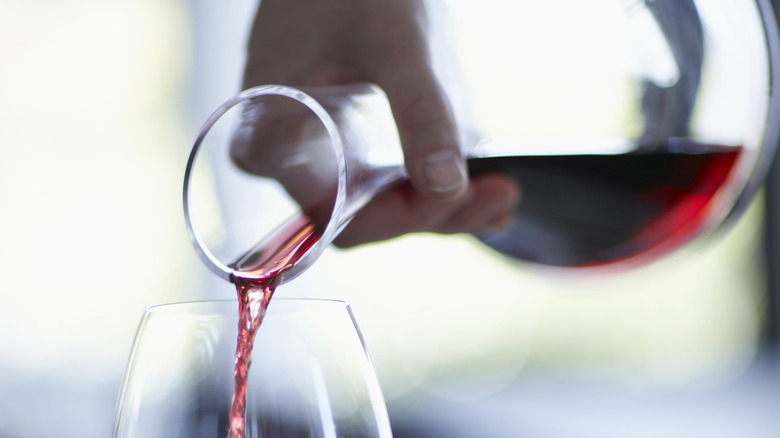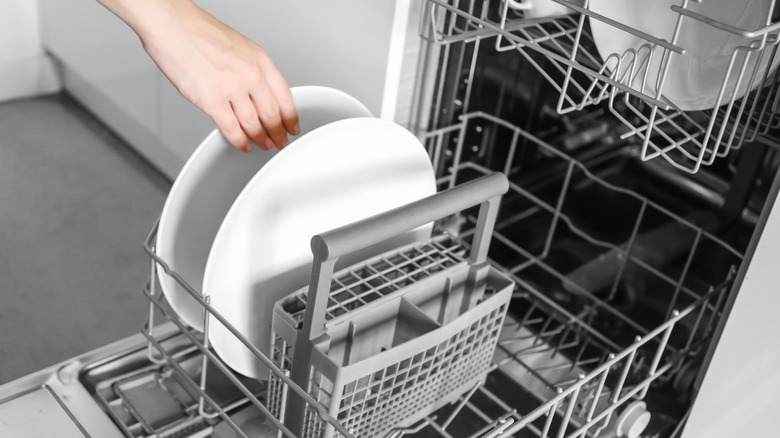Here's The Best Way To Clean That Dirty Wine Decanter
Wine is often not a cheap product, and decanting it is an excellent way to get the most out of your pricey purchase (or even your less pricey wine!). The idea, particularly with red wine, is to slowly pour that delicious fermented beverage into another container from the bottle, freeing it from the sediment that might be sitting at the bottom, as well as allowing the wine's flavors to bloom as it aerates on contact with oxygen.
There's just one problem: Instead of a bottle you're just going to throw away, now you have a separate vessel you have to clean between uses — unless you want your pinot noir to taste like old Merlot, and nobody wants that. Even worse, wine decanters generally have necks far too thin to fit your hand through. So how do you clean those things? It turns out there are several methods depending on what sort of decanter you have, so there's no one-size-fits-all technique.
Rinsing your decanter in lukewarm-to-hot (never boiling) water is a great first step, and will often solve the issue by itself, especially if you're washing it immediately after using it. But there are times when the stains go beyond water's gentle ability to handle (particularly if you've waited around), and that's what the other classic cleaning substances — vinegar and salt — are for.
The best methods are slightly labor intensive, but worth it
Which of these methods you use is going to be heavily determined by your decanter's toughness. If you've got a relatively sturdy one, the salt and ice process is a good call. Simply pour some salt and crushed ice in the decanter, then shake it like you mean it. The salt-ice combo will scour your decanter of stubborn stains, and a rinse will take care of the rest. If your decanter is a little more fragile, though, you're probably going to want to use the vinegar method. Make a mixture of white vinegar, water, and ice, and shake the decanter (gently!) to get everything off.
There's another option, too: decanting beads. These little metal balls are designed to be put in a decanter with warm water, then swirled around. The beads scrape off residue without damaging the glass. The other great thing about decanting beads is they're reusable, so it's not like you have to buy new ones every time.
The last step of the process is the simplest, and it's universal between all of the above cleaning methods: drain out all the liquid (whichever kind you used), then set your decanter upside down on a linen cloth and let it rest until all the water has evaporated. Your decanter should now be fully clean.
You should really avoid the dishwasher
It might be tempting to skip this process and instead just use the dishwasher, but typically, this is a bad idea for a few key reasons. First, many decanters are too sensitive to handle the rough and tumble of a dishwasher, so breaking it is always a concern. Second, dishwashing detergent could very well leave residue behind, and nobody wants cabernet sauvignon with notes of Dawn. This is the same reason you shouldn't use dish soap when cleaning your decanter; streaks of soap residue aren't just unsightly, they're potentially detrimental to the wine's taste.
By the same token, if you're manually cleaning inside the decanter itself, you should use the right tools for the job. There are decanter cleaning brushes for this purpose, but they're not your only option; you can also use a soft, pliable spatula wrapped in a soft material like cheesecloth. You should never use any sort of abrasive sponge, though, as it can scratch the glass.
You've got a lot of options when trying to clean a decanter, so just look at the particular type of decanter you have, then try them out and see what works best for you.


